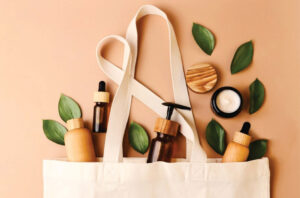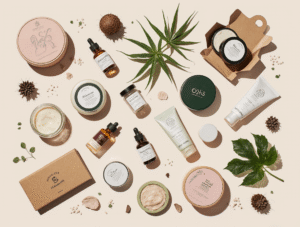In today’s world, the importance of selecting authentic eco-friendly cosmetics is becoming increasingly clear. Many people are turning toward natural and sustainable beauty products because they offer numerous benefits for both skin health and environmental sustainability. However, navigating the marketplace for truly sustainable beauty items can be challenging. Unfortunately, many brands employ greenwashing tactics—misleading consumers by exaggerating their eco-friendly claims. In this comprehensive guide, we’ll provide practical advice and actionable steps to help you confidently select authentic eco-friendly cosmetics.

Check the Ingredients List
One of the essential steps in choosing authentic eco-friendly cosmetics is thoroughly checking the ingredients list. Genuine natural cosmetics will primarily contain ingredients derived from nature, including botanical extracts, plant-based oils, and essential oils. Conversely, it’s crucial to avoid synthetic chemicals and additives, as these can be harmful both to your health and the environment.
Eco-Friendly Ingredients to Look For
- Shea Butter – A deeply nourishing natural moisturizer that is ethically sourced, rich in vitamins A, E, and fatty acids. Shea butter helps to maintain skin elasticity, reduce inflammation, and protect the skin barrier. It’s particularly beneficial for sensitive, dry, or irritated skin conditions like eczema and psoriasis. Study on anti-inflammatory properties of shea butter
- Coconut Oil – Renowned for its hydrating and antimicrobial properties, coconut oil helps to strengthen and protect the skin barrier, retain moisture, and reduce inflammation. Due to its versatility, it’s often used in various beauty products such as moisturizers, hair conditioners, and makeup removers. See scientific review on coconut oil benefits
- Aloe Vera – Celebrated for its soothing, hydrating, and healing properties, aloe vera contains vitamins, antioxidants, and enzymes that help reduce inflammation, redness, and irritation. It’s biodegradable and highly effective in treating skin conditions like sunburn, acne, and dermatitis. Read more in this research article
- Beeswax – A natural and sustainable alternative to synthetic waxes, beeswax effectively retains moisture, creating a protective barrier on the skin. It is rich in vitamin A, providing hydration and softening the skin, making it particularly suitable for sensitive or dry skin.
- Essential Oils – Extracted naturally from plants through steam distillation or cold pressing, essential oils offer numerous therapeutic benefits. They provide natural fragrance, possess antibacterial and antifungal properties, and can enhance mood and relaxation. Popular choices include lavender, tea tree, peppermint, and rosemary.
- Kaolin Clay – A gentle, mineral-based ingredient beneficial for detoxifying, exfoliating, and cleansing the skin. Kaolin clay is excellent at absorbing excess oil, removing impurities, and reducing skin irritation without causing dryness, making it especially suitable for sensitive and acne-prone skin.
Harmful Ingredients to Avoid
- Parabens – Common preservatives linked to hormone disruption and potential health issues. Studies by the Environmental Working Group (EWG) have shown concerns over their safety.
- Sulfates – Often found in cleansers, sulfates strip the skin’s natural oils, leading to dryness and irritation.
- Phthalates – These chemicals, often hidden under “fragrance,” have been associated with endocrine disruption and fertility issues.
- Artificial Fragrances – Known to trigger allergies, asthma, and respiratory issues due to their chemical composition.
- Silicones – Non-biodegradable substances commonly used for texture but harmful to the environment and potentially pore-clogging.
- Microplastics – Tiny plastic particles prevalent in exfoliants, which contaminate waterways, harm marine ecosystems, and enter the food chain. Learn more from American Chemical Society.
Always choose products with certified organic and naturally derived ingredients. Be wary of products with overly complicated ingredient lists containing many synthetic chemicals.
Look for Reliable Certifications
Certifications help consumers identify authentic eco-friendly cosmetics more easily. Trusted certifications indicate that a product meets stringent environmental and ethical standards. Key certifications include:
- USDA Organic – Guarantees at least 95% organic ingredients.
- ECOCERT – Globally recognized for rigorous environmental and sustainability standards.
- Leaping Bunny – Ensures products are cruelty-free and have not been tested on animals.
- COSMOS Organic – Validates compliance with high standards for natural and organic ingredients.
Products bearing these certifications are typically more reliable, eco-friendly, and safe for personal use.
Consider the Packaging
The environmental impact of beauty products extends beyond ingredients to packaging. Many beauty brands excessively use plastic packaging, contributing significantly to pollution. When choosing authentic eco-friendly cosmetics, consider the following sustainable packaging options:
- Glass Containers – Recyclable, reusable, and more sustainable compared to plastics.
- Refillable Options – Many sustainable brands offer refillable solutions to reduce packaging waste.
- Biodegradable Packaging – Made from plant-based materials that naturally decompose.
- Minimal Packaging – Brands that use less packaging naturally produce less waste.
Choosing products with sustainable packaging significantly reduces environmental impact.
Research the Brand’s Ethical Practices
When evaluating a beauty brand’s ethical practices, consider these key questions:
- Does the brand test products or ingredients on animals? Look for cruelty-free certifications like Leaping Bunny or PETA-approved symbols. These indicate products haven’t been tested on animals.
- Are ingredients ethically and sustainably sourced? Check if the company uses responsibly harvested ingredients and supports sustainable farming. Ethical sourcing also ensures fair treatment for workers.
- Does the brand support fair trade and fair labor practices? Confirm the brand works with suppliers who pay fair wages and provide safe working conditions. Certifications like Fair Trade or Rainforest Alliance help verify this.
- What environmental initiatives does the brand support? Look into the brand’s involvement in environmental projects, such as recycling programs, sustainable packaging, or wildlife conservation.
- How transparent is the brand about their supply chain? Ethical brands clearly share information on sourcing, production, and partnerships, helping consumers make informed decisions.
Thoroughly researching brands using these questions ensures your purchases positively impact people and the planet.

Beware of Greenwashing
Greenwashing is a significant challenge in the beauty industry, with many companies using misleading marketing to appear eco-friendly. It’s essential to recognize common greenwashing tactics, including:
- Vague and ambiguous terms like “natural” or “clean beauty” without evidence.
- Images depicting nature without substantial environmental commitments.
- A small portion of natural ingredients mixed with predominantly synthetic chemicals.
- Lack of third-party verification or certification.
Always cross-check brand claims with certified labels and ingredient transparency to avoid greenwashing traps.
Choose Multi-Purpose Products
A straightforward way to reduce environmental waste and simplify your beauty routine is to select multi-purpose cosmetics. These versatile products save resources and money. Examples include:
- Tinted Lip Balm – Can double as both lip color and cheek blush.
- Coconut Oil – Serves multiple purposes as moisturizer, makeup remover, and hair conditioner.
- Aloe Vera Gel – Functions effectively as a skin hydrator, after-sun care product, and redness reducer.
Using fewer products decreases environmental impact and streamlines personal care.
Support Sustainable Beauty Brands
Brands such as Lush, RMS Beauty, and Ilia Beauty exemplify authentic eco-friendly cosmetics through transparency, sustainable packaging, and ethical sourcing. According to the Environmental Working Group, choosing certified non-toxic cosmetics reduces chemical exposure significantly.
How to Find Authentic Eco-Friendly Brands
- Look for brands committed explicitly to environmental responsibility.
- Read customer reviews on platforms such as Reddit and beauty forums to gauge authentic experiences.
- Verify transparency about ingredients and sourcing on the brand’s official website.
- Avoid brands with a known history of greenwashing.
Personal experience underscores the importance of using authentic eco-friendly cosmetics. After suffering persistent skin irritations from synthetic beauty products, I switched to cosmetics containing natural ingredients like shea butter and aloe vera. Not only did my skin condition improve drastically, but my overall well-being and confidence increased.
On online forums, many users share similar experiences. One Reddit user reported relief from chronic eczema after transitioning entirely to eco-friendly skincare. Another shared their satisfaction from dramatically reducing household waste by using refillable beauty products.
Selecting authentic eco-friendly cosmetics is essential for personal health and environmental sustainability. By carefully evaluating ingredients, verifying certifications, assessing sustainable packaging, and supporting ethical brands, you can make informed choices. Beware of greenwashing tactics and prefer multi-purpose products when possible. Integrating authentic eco-friendly cosmetics into your daily routine not only enhances your skin’s health but actively contributes to a healthier planet.
Storage and Shelf Life of Homemade Products: Best Practices for Long-Lasting Quality

I’m Victoria, the creator behind Eva My Balance. Passionate about beauty, wellness, sustainable living, and mindful self-care. My mission is to inspire you to live consciously and beautifully—inside and out.


